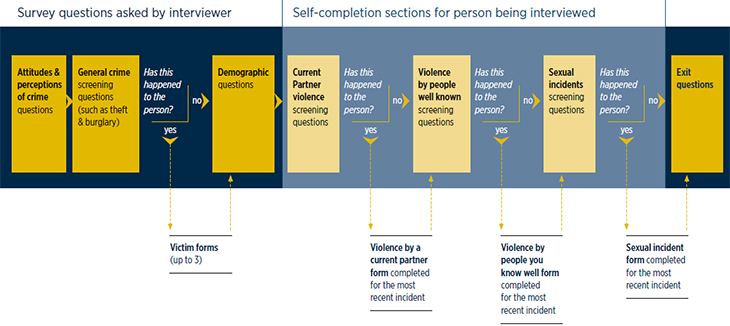What questions are asked?
This page gives a summary of how the questionnaire for the 2014 New Zealand Crime and Safety Survey (NZCASS) is structured and what types of questions are asked.
How is the questionnaire structured?
The NZCASS questionnaire has two main sections:
1. Interviewer-administered (CAPI) section
The interviewer asks the survey participant about their attitudes to and perceptions of crime, whether they have been the victim of a range of personal and household crimes, and demographic questions.
2. Self-completion (CASI) section
This section asks a range of questions about crime where the offender was known to the victim or where a crime was of a sensitive or personal nature. Survey participants were asked to enter these answers into the computer themselves. This is to make sure that any answers to sensitive questions stayed confidential and to help people feel more comfortable.

Infographic summary of NZCASS questionnaire [JPG, 135 KB]
What questions are asked?
Attitudes and perceptions of crime
These questions cover attitudes to neighbourhood crime and incivilities, fear and worry about crime, household security and neighbourhood support, and confidence in the criminal justice system.
Victim screener questions (general crime)
These questions ask about different things (incidents) that might have happened to the survey participant or their household. These questions collect information on a range of personal offences and household offences.
The NZCASS does not ask survey participants directly about crimes that happened to them, such as ‘Have you been burgled?’
This is because people don’t always know what are legally considered crimes, and what aren’t. Once collected, the incidents are coded by legal experts (Offence coding) to determine whether or not the incident was a crime, and what type of crime.
General victim forms
The participant can then fill in up to three general victim forms, based on their answers to the victim screening questions.
The victim forms include questions about (but are not limited to) contact with the offender, insurance, weapons, whether medical attention was sought, emotional reactions, reporting to Police (or other services), victims needs, and perceptions about the seriousness of the incident.
Demographics
These questions cover the survey participant’s age, ethnicity, employment status, marital status, personal and household income, household composition, household size, tenure, and economic hardship.
Partner violence (self-completion)
The participant types in the answers to this part of the questionnaire to make sure that responses are private and confidential from the interviewer.
Questions include things that a current partner (at the time of the incident) might have done, such as assaults, threats of assault, damage to personal property, and threats of damage to personal property. In addition to the general victim form questions noted above, this part of the questionnaire asks if the participant has also experienced violence or coercive or controlling behaviour by other partners (“Lifetime prevalence”).
Violence by people well known (self-completion)
Questions in this section ask about things that ex-partners, family members or other types of people that are well known to the victim might have done. The questions are similar to those under ‘partner violence’ above.
Sexual violence (self-completion)
Questions in this section ask about things that might have happened, such as rape, attempted rape, distressing sexual touching, and other sexual violence or threats.
The latest questionnaire
If you want to know what data or information is available to help answer a research question, please refer to the Data items (variables) list
Download the 2014 NZCASS questionnaire [PDF, 1.2 MB]
This page was last updated:
